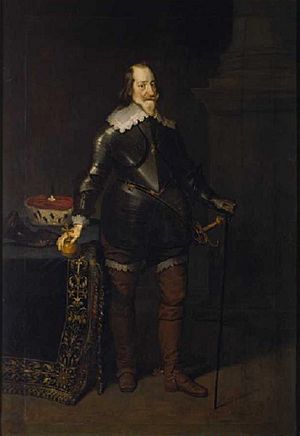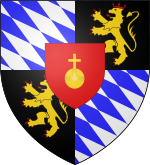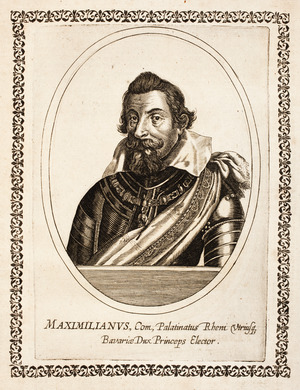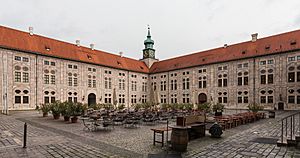Maximilian I, Elector of Bavaria facts for kids
Quick facts for kids Maximilian I |
|
|---|---|
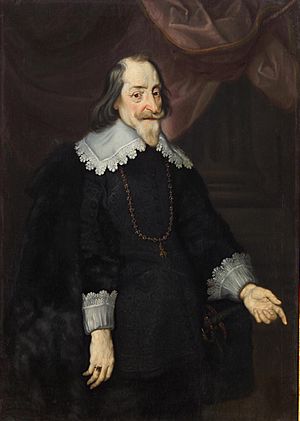
Portrait by Joachim von Sandrart (1643)
|
|
| Duke of Bavaria | |
| Reign | 15 October 1597 – 25 February 1623 |
| Predecessor | William V |
| Elector Palatine | |
| Reign | 23 February 1623 – 24 October 1648 |
| Predecessor | Frederick V |
| Successor | Charles I Louis |
| Elector of Bavaria | |
| Reign | 25 February 1623 – 27 September 1651 |
| Successor | Ferdinand Maria |
| Born | 17 April 1573 Munich |
| Died | 27 September 1651 (aged 78) Ingolstadt |
| Burial | St. Michael's Church, Munich |
| Spouses |
Elisabeth of Lorraine
(m. 1595; died 1635) |
| Issue | Ferdinand Maria, Elector of Bavaria Duke Maximilian Philipp Hieronymus |
| House | Wittelsbach |
| Father | William V, Duke of Bavaria |
| Mother | Renata of Lorraine |
| Religion | Roman Catholicism |
| Signature |  |
Maximilian I (born April 17, 1573 – died September 27, 1651) was a powerful ruler from the House of Wittelsbach. He was known as the Great sometimes. He ruled as the Duke of Bavaria starting in 1597.
His time as ruler was very important. It included the Thirty Years' War, a huge conflict in Europe. During this war, he gained the title of a Prince-elector in the Holy Roman Empire. This happened at a meeting called the Diet of Regensburg in 1623.
Maximilian was a skilled leader. He made Bavaria a stronger state. He was a very religious Catholic. He strongly supported the Counter-Reformation, which was the Catholic Church's response to the Protestant Reformation. He also helped create the Catholic League, a group of Catholic rulers.
During the Thirty Years' War, he took control of the Upper Palatinate region. He also gained the Electoral Palatinate from his cousin, Frederick V. The Peace of Westphalia in 1648 ended the war. This treaty allowed Maximilian to keep Upper Palatinate. He also kept the important title of Elector for his family.
Contents
Early Life and Family
Maximilian I was born in Munich. He was the oldest son of William V, Duke of Bavaria and Renata of Lorraine who lived past infancy. He was taught by the Jesuits, a Catholic religious order. He started helping with the government in 1591.
In 1595, he married his cousin, Elisabeth of Lorraine. She was also known as Elisabeth Renata. She was the daughter of Charles III, Duke of Lorraine. Maximilian became the Duke of Bavaria in 1597. This happened when his father stepped down from power.
Maximilian's first marriage to Elisabeth Renata did not have any children. A few months after she passed away, Maximilian married again. On July 15, 1635, he married his niece, Maria Anna of Austria (1610-1665). She was 25 years old. This marriage happened quickly. Maximilian wanted to have a son to take over his rule.
Maria Anna was very interested in politics. She supported Bavaria's goals. She had two sons with Maximilian. They were Ferdinand Maria, who became the next ruler, and Maximilian Philip.
Maximilian was a very smart ruler for his time. He wanted to stop Germany from being a battleground. He was a strong Catholic. But he did not always follow the church without question. He was not very strong physically. But he had big goals for himself and Bavaria. He was determined and clever in reaching his aims.
Maximilian and the Thirty Years' War
Maximilian did not get involved in German politics much until 1607. At that time, he was asked to deal with the city of Donauwörth. This city was a Protestant area. In December 1607, his soldiers took over the city. They worked hard to bring back Catholicism.
Some Protestant rulers were worried by this. They formed the Protestant Union to protect their interests. In response, the Catholic League was created in 1609. Maximilian played a big part in forming this League. He helped create an army for the League. But he wanted the League to be for defense only. He did not want it to be used by the Habsburg family for their own goals.
Disagreements among the Catholic League leaders caused Maximilian to leave his role in 1616. But problems started again, so he returned to the League about two years later.
In 1619, Maximilian refused to become the Holy Roman Emperor. Soon after, war broke out in Bohemia. Maximilian made a deal with Ferdinand II, Holy Roman Emperor in October 1619. In return for some benefits, he offered the League's army to the emperor. He wanted to keep the fighting from spreading. He made a deal with the Protestant Union to stay neutral. He also took control of Upper Austria to cover the costs of the war.
On November 8, 1620, his troops won a big victory. Their leader, Johann Tserclaes, Count of Tilly, defeated the forces of Frederick, King of Bohemia. This happened at the Battle of White Mountain near Prague. After this, Ferdinand II let Maximilian control Upper Austria until 1628.
Even with the agreement, Tilly's army damaged the Rhenish Palatinate. In February 1623, Maximilian was officially given the title of prince-elector. This was a very important position. It had been held by the Counts Palatine of the Rhine since 1356. Maximilian also received the Upper Palatinate region. He returned Upper Austria to Ferdinand.
Maximilian then became a leader of the group that wanted to remove Albrecht von Wallenstein from the emperor's service. Wallenstein was a powerful general. At the Diet of Regensburg (1630) meeting, Ferdinand had to agree to this. But this decision caused problems for Bavaria and Maximilian. Maximilian tried to stay neutral in the war. He signed a secret agreement with France in 1631. But this agreement did not help much.
In early 1632, Gustavus Adolphus of Sweden, a Swedish king, marched into Bavaria. He took over Munich. Maximilian could only get help from the Imperial army by following Wallenstein's orders. Wallenstein was back in charge of the emperor's forces.
The Swedes and their French allies caused a lot of damage. This made Maximilian try to make peace with them. He also tried to get Protestants on his side. He suggested changes to an old law called the Edict of Restitution from 1629. But these efforts did not work.
In September 1638, Baron Franz von Mercy became a top general in Bavaria's army. Bavaria had the second-largest army in the Holy Roman Empire. Mercy and Johann von Werth fought against France and Sweden. They had mixed success.
In March 1647, Maximilian made a deal called the Truce of Ulm (1647) with France and Sweden. But Ferdinand III, Holy Roman Emperor asked him to break this promise. Bavaria was attacked again. Maximilian's forces were defeated in May 1648 at the Battle of Zusmarshausen.
The Peace of Westphalia soon ended the war. This treaty said that Maximilian would keep his title of Elector. This title would now pass down in his family. He also kept Upper Palatinate. But Maximilian had to give up the Lower Palatine. This land was given back to Charles Louis. He was the son of Frederick V.
Improvements and Art
Maximilian made Bavaria's money situation much better. He reorganized how the government and army worked. He also brought in new economic rules called mercantilist measures. He created a new set of laws called the Codex Maximilianeus.
In 1610, Maximilian ordered the Munich Residenz palace to be made bigger. He also improved the Hofgarten, a beautiful garden. The first buildings of Schleissheim Palace were expanded between 1617 and 1623. This was done by Heinrich Schön and Hans Krumpper. It became known as the Old Palace.
Maximilian bought many paintings for the Wittelsbach collection. These included works by famous artists like Albrecht Dürer and Peter Paul Rubens. For example, in 1616, he asked Peter Paul Rubens to paint four hunting scenes. In 1627, he even got Dürer's The Four Apostles by pressuring the city leaders of Nuremberg. His court artists included Peter Candid, Friedrich Sustris, Hubert Gerhard, Hans Krumpper, Adrian de Vries, and Georg Petel.
Maximilian died in Ingolstadt on September 27, 1651. He is buried in St. Michael's Church, Munich. In 1839, King Ludwig I of Bavaria put up a statue in Munich to remember him.
Family and Children
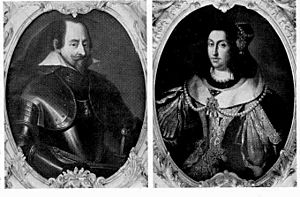
On February 6, 1595, Maximilian married his first cousin, Princess Elisabeth of Lorraine (1574–1635). She was the daughter of Charles III, Duke of Lorraine. They did not have any children.
On July 15, 1635, Maximilian married his niece, Maria Anna of Austria (1610-1665). She was the daughter of Ferdinand II, Holy Roman Emperor. They had two sons:
- Ferdinand Maria (1636–1679) He married Princess Henriette Adelaide of Savoy in 1652.
- Maximilian Philipp Hieronymus, Duke of Leuchtenberg (1638–1705) He married Maurita Febronia de La Tour d'Auvergne in 1668.
See also
 In Spanish: Maximiliano I, duque y elector de Baviera para niños
In Spanish: Maximiliano I, duque y elector de Baviera para niños


